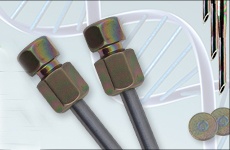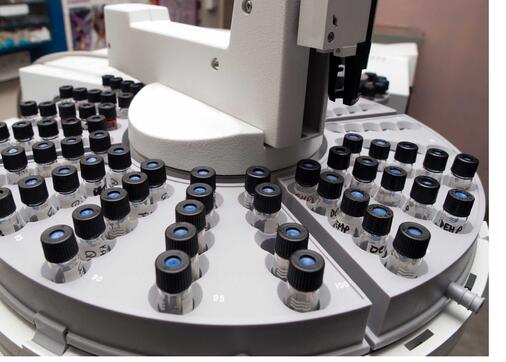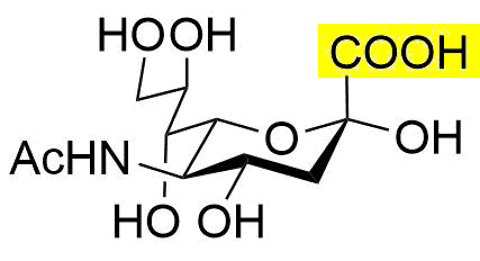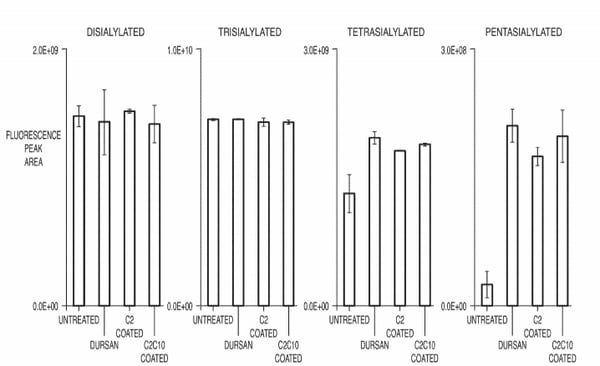
Protein biologic molecule analysis using HPLC is big business. Let's discuss how Dursan® coating contributes to improving protein analysis in HPLC systems.
According to data collected by Nature and Medscape, in 2010, the top ten selling drugs in the United States totaled just over $38 billion dollars in sales, and all ten drugs were small molecule drugs. In 2018, the top ten drugs sold totaled $89 billion in sales, and 8 of the top 10 were biologics. Since biologics and biosimilar molecules have the ability to cure diseases that preferentially target the older generations such as certain cancers and chronic pain, many experts in the industry expect this growth to continue due to the world’s aging population.
Due to the complex nature of biologics, the analysis and purification of these large molecules can be challenging. Liquid chromatography plays a big role in the R&D, scale up, and production stages of new drug development. One of the challenges involved in performing good separations on biologics includes finding hardware that will allow for superior chromatography, which is essential for accurate purity analysis and production. Stainless steel is the most popular material for liquid chromatography hardware, but it tends to be a reactive material, especially with certain analytes such as monoclonal antibodies, proteins, phosphates, and many other biomolecules that are produced in the pharmaceutical industry.

Other metal alloys such as titanium and MP35N experience similar reactivity, albeit to a lesser extent. Inert plastic hardware such as PEEK has varying internal diameters which can adversely affect analysis, and they cannot handle the high pressures needed for advanced separation techniques. SilcoTek’s Dursan® process applies a CVD coating on ready-made parts that can provide the robustness of stainless steel and the inertness of PEEK.
This blog post will discuss the bio-inert properties that the Dursan® process imparts on HPLC column hardware and how it can be used in the analysis and purification of biologics and biosimilar molecules. It will specifically focus on a patent application recently filed by Waters Corporation that compared Waters’ CVD coatings to Dursan®.
|
In this blog post you will learn:
- How Dursan coating antifouling properties improve high performance liquid chromatography protein analysis.
- How a comparative test evaluation proved Dursan coated surfaces perform better than stainless steel and other coatings.
- How Dursan performs in multisialylated glycan analysis.
|
Discussion and data:
A previous study, in collaboration with Abbott Laboratories, showed that the Dursan® coating process enhances stainless steel by reducing the adhesion of various proteins to the substrate. The study included bovine serum albumin, mouse immunoglobulins, normal human plasma, and poly-L-lysine. Dursan® produced antifouling properties that were not specific to any one type of biomolecule. Customers have also reported that Dursan® on HPLC columns and frits has been a benefit, especially when performing biomolecule analysis. While they have not shared data with us, we have gathered testimonials. One customer wrote:
“The coated columns have so far passed all tests bravely. The chromatographic separation in standard samples remains unchanged; in the case of biomolecules the results were, as expected, much better than in normal steel columns, but also better than in the case of pure PEEK columns.”

Recently, Waters Corporation filed a patent application describing their own set of CVD coatings for column hardware. A variety of tests were performed comparing the coated and uncoated hardware, similar to some of SilcoTek’s studies on the Dursan® process. One experiment involved the separation of N-glycans produced from bovine fetuin. Fetuins are blood proteins that are made in the liver and are responsible for transporting a wide variety of cargo throughout the body. A deficit in fetuin-A in humans is a predictor of increased disease activity in obstructive lung disease, Crohn’s disease, and ulcerative colitis.
Glycoproteins, such as fetuin, are proteins that contain oligosaccharide chains that are covalently bound to the amino acid side-chains called glycans. Gathering a profile of these glycans from such proteins is a critical quality attribute of that protein as it can be a measure of efficacy, immunogenicity, and manufacturing conditions. One of the most common approaches to gathering a glycan profile is deglycosylation of the protein where the glycans are removed, separated, and analyzed on their own. This method allows for the analysis to be performed without any interference from the protein itself. The resulting glycans contain sialic acid residues, all of which contain a carboxylate functional group as seen in Figure 2. These carboxylate groups have a relatively weak affinity toward metals.

Figure 2: N-Acetylneuraminic acid is the predominant sialic acid found in many mammalian cells.
Highlighted is the carboxylate group that has a very weak binding affinity for metals.
The sample sialic acid in Figure 2 is considered a monosialylated glycan, or a simple glycan. Just as simple sugars like glucose, fructose, and galactose can link to form more complex sugars, simple glycans can link together to form more complex glycans. As more glycans bond together, there are a larger number of carboxylate groups that have a weak affinity toward metals. Waters Corporation found that three or less sialic acid residues do not seem to have an affect on peak areas in their separations as seen in Figure 3. Once four or more are linked together, the opportunity for polydentate chelation is created, and the uncoated metal hardware shows significant losses in signal. The coating produced by the Dursan® process clearly shows an advantage over uncoated hardware, and appears to outperform Waters Corporation’s coatings under these conditions as well.

Figure 3: Peak areas for multisialylated glycans. Molecule compares bare stainless steel hardware to
Dursan and two CVD coatings done by Waters Corporation (C2 and C2C10).
As more sialic acid residues are added, the stronger the binding affinity is toward the metal hardware.
Conclusion:
The growth of biologics and biosimilars in the pharmaceutical world requires more rigorous and accurate testing equipment. Liquid chromatography is used through the R&D, scale up, and production phases of product development. Stainless steel, the common material choice for liquid chromatography hardware, can have reactivity toward numerous biological molecules causing difficulties during analysis, especially at trace levels. The Dursan® process can provide a bio-inert surface that will allow for the analysis and purification to be done on these sensitive molecules while not having an adverse effect on non-metal active molecules. Here, the Dursan® process provides the inertness necessary for the analysis of N-glycans produced from bovine fetuin. This analysis can be crucial in the development of biologic drugs as well as quality control during production of the drugs.
References:
Lauber, Matthew A., et al. "Use of vapor deposition coated flow paths for improved chromatography of metal interacting analytes." U.S. Patent Application No. 16/133,089.





